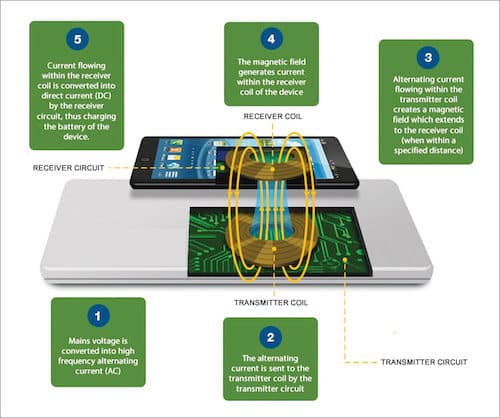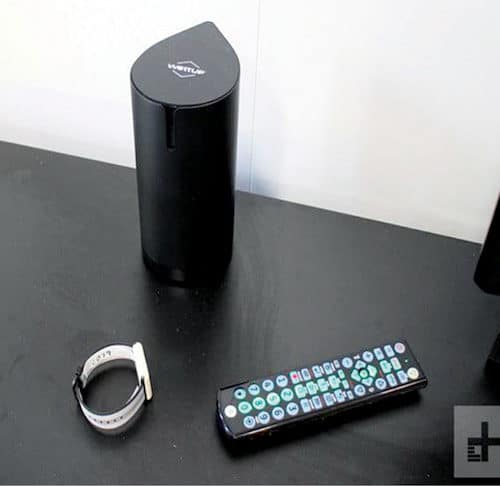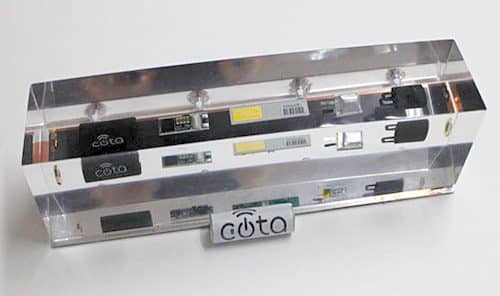Wireless charging will increase mobility for users of Internet of Things (IoT) devices. This article explores the technology and its applications, challenges to overcome while designing and the latest advances in this field.
Wireless charging eliminates the requirement of charging cables and allows charging of multiple devices in parallel. There are no charging cable incompatibility issues. Basically, wireless charging works on the principle of electromagnetic induction: Time-varying magnetic field induces current in a closed loop of wire to transfer power from the transmitter to the receiver without requiring physical connection.
Wireless charging allows auto shutdown when charging is complete. As it does not require mechanical connectors, manufacturing cost is less. Embedding this technology in mobiles will allow mobile manufacturers to do away with power supply sockets, which allow entry to water, dust and other corrosive materials.
Application areas
Apple announced its wireless charging mat AirPower, which is capable of charging iPhone, Apple Watch and AirPods simultaneously. Ikea provides a wide range of wireless charging furniture that support Qi standard. Wireless charging-compatible devices include notebooks, tablets, smartphones, wearables, multicopters, electric toys, cameras, speakers, power tools, service robots such as vacuum cleaners, in-car chargers, electric vehicles, medical devices, etc. Wireless charging can also be used to recharge embedded medical devices via a magnetic field through the skin, avoiding the risk of infection.

Mediatek principal engineer Sandeep Arya informs that their company provides multi-mode resonant wireless charging solutions for most of the afore-mentioned applications. Their smart receiver resonator architecture simplifies design and delivers seamless charging across different pads. Mediatek manufactures wireless charging integrated circuit (IC) chipsets. Pump Express 4.0 is the latest advance in MediaTek’s family of charging innovations that cuts the charging time by half.
How the technology works?
To charge your device, you need a wireless charger or a wireless charging case with Qi integrated. The charger uses an induction coil to create an alternating electromagnetic field, which induces current to be fed into the battery by the receiver coil in the phone.
Wireless charging works by converting mains voltage into high-frequency alternating current (AC). This AC current is sent to the transmitter coil by the transmitter circuit. AC current flowing within the transmitter coil creates a magnetic field, which extends to the receiver coil. The magnetic field generates current within the receiver of the coil, thus transferring energy from the charger to a receiver in the back of the phone via electromagnetic induction. The receiver circuit converts the current flowing within the receiver coil into direct current (DC), thus charging the battery of the device. Both your smartphone and the charging pad have an LED indicator, which glows while charging.
Latest technology trends
There are two major standards for wireless power charging: Qi (Chee) from Wireless Power Consortium (a group of companies) and PowerMat from AirFuel Alliance. Both products utilise resonant inductive coupling technology. PowerMat has installed thousands of charging spots in European cafes, hotels and airports. Airfuel has announced wireless charging installation at McDonald’s restaurants. PowerMat has joined the Wireless Power Consortium. So it’s now one of the companies supporting Qi standard alongside Apple, Samsung, LG and more.

The new platform charging spot 4.0 is easy to install and compatible with many devices. You can find the closest charging station by downloading the app. You just need to walk into a charging station and set your phone on the table to begin wireless charging. For non-compatible smartphones, the company offers a PowerMat ring. When plugged into the smartphone, it starts power transfer wirelessly. It can be easily placed under the table without drilling through it and can transfer power through 1.3 to 3.8cm (0.5 to 1.5inch) thick surfaces. There can be eight charging spots installed on a table that supports zero to 40 watts of charging power on a single platform and is also compatible with Qi.

Design tips for engineers
To overcome wireless charging issues like low efficiency, heat dissipation, cost and short-distance transmission, manufacturers need semiconductor solutions. Efficient and easy-to-design transmitter solutions top the list.
Smart heat management keeps the transmitter and surface at working temperature range, keeping the device battery from heating during charging. Design should be compact and easy to carry. Faster charging speed can be achieved by lowering switching and conduction losses.
In place of GaN, Infineon uses mature and reliable silicon technology to achieve a high performance. It is currently working on boosting the performance further with medium-voltage GaN solutions that have the same maturity level as silicon devices.
Vinay, a sales representative from Mouser, informs that their solutions utilise inductive charging, and that they have further reduced the leakage field by providing an EMI shield at the back of the coil to achieve an efficiency of up to 93 per cent.
Wireless charging using RF waves
The recent Mobile World Congress saw demos of two emerging wireless charging technologies.
Energous demonstrated a prototype set up as a transmitter, capable of sending power via radio frequencies to a smartwatch, a phone and a pair of wireless earbuds up to one metre (3 feet) away. It has also secured FCC approval.
Ossia demonstrated a device that transmits power using radio frequencies in the same 2.4GHz band as Wi-Fi, but at a different channel to avoid interference. It can charge phones from a distance of around three metres (10 feet). Charging speed goes down as you move away. The device was able to charge even when the smartphone was kept in a pocket.
Both the inventors are looking for manufacturers who can integrate the technology into chipsets and compact devices. So there is a lot of scope for different manufacturers to provide integrated solutions.
Wireless charging offers opportunities for automotive, healthcare and other industries that provide Smart Cities solutions. It will increase mobility by allowing Internet of Things (IoT) devices to charge wirelessly.









